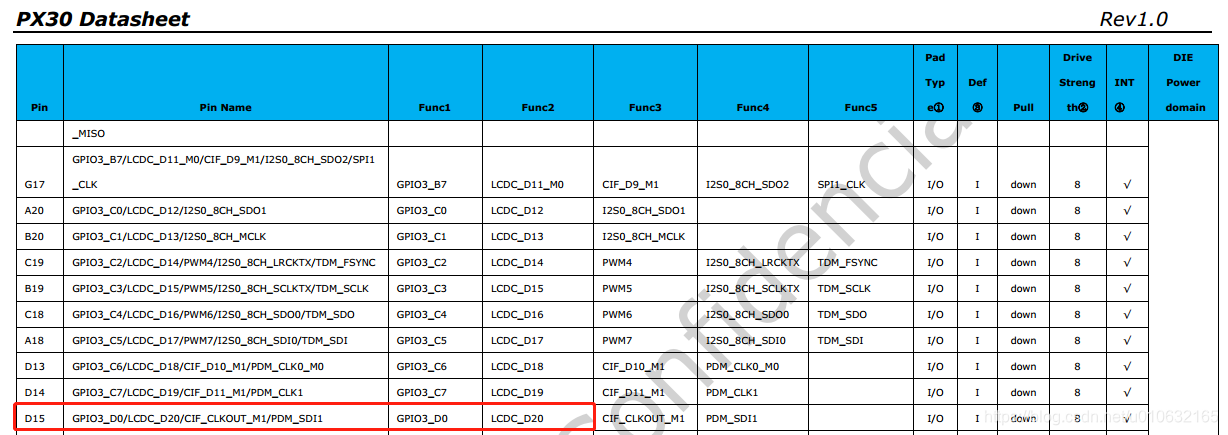Linux内核驱动学习(八)GPIO驱动模拟输出PWM
前言
上一篇的学习中介绍了如何在用户空间直接操作GPIO,并写了一个脚本可以产生PWM。本篇的学习会将写一个驱动操作GPIO,同样的也可以发生PWM,因此这里还需要部分的硬件配合,需要一块开发板,当然可能还需要一台示波器。
原理图
和上一篇相同,引脚依然是GPIO3_D0,具体硬件肯定会不同,注意参考soc的datasheet和硬件原理图,先定位正确需要操作的GPIO。

IO模拟输出PWM
这里驱动实现的方式是先创建一个内核线程,如何创建内核线程可以参考Linux内核驱动学习(五)KThread学习总结,然后在线程函数一直循环反转IO口的输出。这里的目的单纯是为了学习操作GPIO,不建议项目中通过这种IO口模拟的方式去实现PWM的输出,而应该直接使用自带PWM功能的引脚。
设备树
gpio-demo {
compatible = "gpio-demo";
gpios = <&gpio3 0 GPIO_ACTIVE_LOW>;
};
- 1
- 2
- 3
- 4
驱动源码中通过of_get_gpio接口去解析gpio。
驱动端
驱动源码中of_device_id结构体变量中的成员.compatible的值必须和设备树的设备节点兼容属性compatible的值相同;
static struct of_device_id gpio_demo_of_match[] = {
{ .compatible = "gpio-demo"},
{},
}
MODULE_DEVICE_TABLE(of,gpio_demo_of_match);
static struct platform_driver gpio_demo_driver = {
.probe = gpio_demo_probe,
.driver = {
.name = "gpio-demo-device",
.owner = THIS_MODULE,
.of_match_table = of_match_ptr(gpio_demo_of_match),
}
};
- 1
- 2
- 3
- 4
- 5
- 6
- 7
- 8
- 9
- 10
- 11
- 12
- 13
- 14
- 15
在probe函数实现对设备树节点的解析,of_get_gpio对应gpio-demo节点下的gpios属性;
然后ret = devm_gpio_request_one(dev, gpio, GPIOF_DIR_OUT, pdev->name)语句初始化GPIO为输出引脚;
static int gpio_demo_probe(struct platform_device *pdev){
int ret,i;
struct device *dev = &pdev->dev;
struct device_node *node = dev->of_node;
if (!node)
return -EINVAL;
ret = of_gpio_count(node);
if (ret == 0){
return -EINVAL;
}
priv = devm_kzalloc(dev, sizeof(*priv) + sizeof(int) * ret, GFP_KERNEL);
if (!priv){
return -ENOMEM;
}
priv->count = ret;
mutex_init(&priv->mtx);
for (i = 0; i < priv->count; i++) {
unsigned int gpio;
gpio = of_get_gpio(node, i);
if (gpio < 0) {
dev_warn(dev, "Unable to get gpio #%d\n", i);
continue;
}
ret = devm_gpio_request_one(dev, gpio, GPIOF_DIR_OUT, pdev->name);
priv->gpio[i] = gpio;
if (ret < 0) {
dev_warn(dev, "Unable to re quest GPIO %d: %d\n",
gpio, ret);
continue;
}
printk(KERN_INFO "success request gpio %d\n",gpio);
gpio_direction_output(gpio, 1); //设置输出的电平
}
return 0;
}
- 1
- 2
- 3
- 4
- 5
- 6
- 7
- 8
- 9
- 10
- 11
- 12
- 13
- 14
- 15
- 16
- 17
- 18
- 19
- 20
- 21
- 22
- 23
- 24
- 25
- 26
- 27
- 28
- 29
- 30
- 31
- 32
- 33
- 34
- 35
- 36
- 37
- 38
- 39
- 40
线程执行函数中通过gpio_set_value设置GPIO的输出值,然后休眠50毫秒,最终PWM的周期应该是100毫秒左右。
static int thread_func(void *data) {
int i, count;
while (1){
count++;
mutex_lock(&priv->mtx);
for ( i = 0; i < priv->count; i++){
gpio_set_value(priv->gpio[i], count%2);
}
mutex_unlock(&priv->mtx);
msleep(50);
printk(KERN_INFO "thread count %d\n", count);
}
return 0;
}
- 1
- 2
- 3
- 4
- 5
- 6
- 7
- 8
- 9
- 10
- 11
- 12
- 13
- 14
- 15
gpio_set_value和gpio_direction_output的区别
如果使用该GPIO时,不会动态地切换输入输出,建议在开始时就设置好GPIO 输出方向,后面拉高拉低时使用gpio_set_value()接口,而不建议使用gpio_direction_output(), 因为gpio_direction_output接口里面有mutex锁,对中断上下文调用会有错误异常,且相比gpio_set_value,gpio_direction_output所做事情更多,浪费。
调试信息
先通过debugfs查看相应的GPIO已经成功加载到内核了;但是我们目前没有留用户层调用的接口,这个有悖于我们的初衷,但是目前为止已经实现了自己想要的效果。

实验结果

附录
#include <linux/module.h>
#include <linux/init.h>
#include <linux/platform_device.h>
//API for libgpio
#include <linux/gpio.h>
//API for malloc
#include <linux/slab.h>
//API for device tree
#include <linux/of_platform.h>
#include <linux/of_gpio.h>
#include <linux/of_device.h>
//API for thread
#include <linux/kthread.h>
#include <linux/delay.h>
#include <linux/mutex.h>
static struct task_struct *thread_body;
struct gpio_demo_priv{
int count;
int gpio[0];
struct mutex mtx;
int mode;
};
struct gpio_demo_priv *priv;
static int thread_func(void *data) {
int i, count;
while (1){
count++;
mutex_lock(&priv->mtx);
for ( i = 0; i < priv->count; i++){
gpio_set_value(priv->gpio[i], count%2);
}
mutex_unlock(&priv->mtx);
msleep(50);
printk(KERN_INFO "thread count %d\n", count);
}
return 0;
}
static int gpio_demo_probe(struct platform_device *pdev){
int ret,i;
struct device *dev = &pdev->dev;
struct device_node *node = dev->of_node;
if (!node)
return -EINVAL;
ret = of_gpio_count(node);
if (ret == 0){
return -EINVAL;
}
priv = devm_kzalloc(dev, sizeof(*priv) + sizeof(int) * ret, GFP_KERNEL);
if (!priv){
return -ENOMEM;
}
priv->count = ret;
mutex_init(&priv->mtx);
for (i = 0; i < priv->count; i++) {
unsigned int gpio;
gpio = of_get_gpio(node, i);
if (gpio < 0) {
dev_warn(dev, "Unable to get gpio #%d\n", i);
continue;
}
ret = devm_gpio_request_one(dev, gpio, GPIOF_DIR_OUT, pdev->name);
priv->gpio[i] = gpio;
if (ret < 0) {
dev_warn(dev, "Unable to re quest GPIO %d: %d\n",
gpio, ret);
continue;
}
printk(KERN_INFO "success request gpio %d\n",gpio);
gpio_direction_output(gpio, 1); //设置输出的电平
}
platform_set_drvdata(pdev,priv);
thread_body = kthread_create(thread_func, NULL, "thread_pwm");
if((thread_body))
{
wake_up_process(thread_body);
}
return 0;
}
static struct of_device_id gpio_demo_of_match[] = {
{ .compatible = "gpio-demo"},
{},
}
MODULE_DEVICE_TABLE(of,gpio_demo_of_match);
static struct platform_driver gpio_demo_driver = {
.probe = gpio_demo_probe,
.driver = {
.name = "gpio-demo-device",
.owner = THIS_MODULE,
.of_match_table = of_match_ptr(gpio_demo_of_match),
}
};
static int __init gpio_demo_init(void){
return platform_driver_register(&gpio_demo_driver);
}
static void __exit gpio_demo_exit(void){
platform_driver_unregister(&gpio_demo_driver);
}
late_initcall(gpio_demo_init);
module_exit(gpio_demo_exit);
MODULE_LICENSE("GPL");
MODULE_DESCRIPTION("Gpio demo Driver");
MODULE_ALIAS("platform:gpio-demo");
- 1
- 2
- 3
- 4
- 5
- 6
- 7
- 8
- 9
- 10
- 11
- 12
- 13
- 14
- 15
- 16
- 17
- 18
- 19
- 20
- 21
- 22
- 23
- 24
- 25
- 26
- 27
- 28
- 29
- 30
- 31
- 32
- 33
- 34
- 35
- 36
- 37
- 38
- 39
- 40
- 41
- 42
- 43
- 44
- 45
- 46
- 47
- 48
- 49
- 50
- 51
- 52
- 53
- 54
- 55
- 56
- 57
- 58
- 59
- 60
- 61
- 62
- 63
- 64
- 65
- 66
- 67
- 68
- 69
- 70
- 71
- 72
- 73
- 74
- 75
- 76
- 77
- 78
- 79
- 80
- 81
- 82
- 83
- 84
- 85
- 86
- 87
- 88
- 89
- 90
- 91
- 92
- 93
- 94
- 95
- 96
- 97
- 98
- 99
- 100
- 101
- 102
- 103
- 104
- 105
- 106
- 107
- 108
- 109
- 110
- 111
- 112
- 113
- 114
- 115
- 116
- 117
- 118
- 119
- 120
- 121
- 122
- 123
- 124
- 125
- 126
- 127
文章来源: great.blog.csdn.net,作者:小麦大叔,版权归原作者所有,如需转载,请联系作者。
原文链接:great.blog.csdn.net/article/details/89722539
- 点赞
- 收藏
- 关注作者


评论(0)